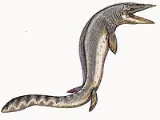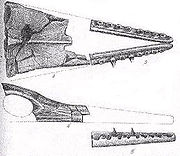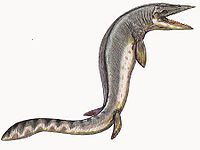
Taniwhasaurus
Encyclopedia
Taniwhasaurus is an extinct genus
of mosasaur
, a carnivorous, marine reptile
which inhabited New Zealand
, Japan
and Antarctica. The genus was a close relative of the genera Tylosaurus
and Hainosaurus
.


for Taniwhasaurus, was named by Hector in 1874 from a fossil specimen found in the late Campanian
Conway Formation
outcrops at Haumuri Bluff, New Zealand.
Known from an individual that may have measured at least 20+ feet in length, based on the estimations of the remains found. It is synonymous with Tylosaurus haumuriensis, which was named more recently, from the front parts of the jaws.
of James Ross Island
, Antarctica. When the type material was reexamined in 2007, James E. Martin and Marta Fernández determined Lakumasaurus to be a junior synonym
of Taniwhasaurus and recombined the species Lakumasaurus antarcticus as T. antarcticus.
. Originally thought to be a theropod dinosaur
, it was later identified as a mosasaur
or ichthyosaur
which lived in what is now Japan. The "type species
", "Yezosaurus mikasaensis", was coined by Obata and Muramoto in 1977, but was not formally described until 2008, when the species T. mikasaensis was described by M.W. Caldwell et al.
Genus
In biology, a genus is a low-level taxonomic rank used in the biological classification of living and fossil organisms, which is an example of definition by genus and differentia...
of mosasaur
Mosasaur
Mosasaurs are large extinct marine lizards. The first fossil remains were discovered in a limestone quarry at Maastricht on the Meuse in 1764...
, a carnivorous, marine reptile
Reptile
Reptiles are members of a class of air-breathing, ectothermic vertebrates which are characterized by laying shelled eggs , and having skin covered in scales and/or scutes. They are tetrapods, either having four limbs or being descended from four-limbed ancestors...
which inhabited New Zealand
New Zealand
New Zealand is an island country in the south-western Pacific Ocean comprising two main landmasses and numerous smaller islands. The country is situated some east of Australia across the Tasman Sea, and roughly south of the Pacific island nations of New Caledonia, Fiji, and Tonga...
, Japan
Japan
Japan is an island nation in East Asia. Located in the Pacific Ocean, it lies to the east of the Sea of Japan, China, North Korea, South Korea and Russia, stretching from the Sea of Okhotsk in the north to the East China Sea and Taiwan in the south...
and Antarctica. The genus was a close relative of the genera Tylosaurus
Tylosaurus
Tylosaurus was a mosasaur, a large, predatory marine lizard closely related to modern monitor lizards and to snakes.-Paleobiology:...
and Hainosaurus
Hainosaurus
Hainosaurus is an extinct genus of marine lizard belonging to the mosasaur family. It was one of the largest mosasaurs, though its size has been revised more than once. At first it was estimated to be , and the largest mosasaurid. During the 1990s, its size was revised to long; more recently,...
.
Species


T. oweni
Taniwhasaurus oweni, the type speciesType species
In biological nomenclature, a type species is both a concept and a practical system which is used in the classification and nomenclature of animals and plants. The value of a "type species" lies in the fact that it makes clear what is meant by a particular genus name. A type species is the species...
for Taniwhasaurus, was named by Hector in 1874 from a fossil specimen found in the late Campanian
Campanian
The Campanian is, in the ICS' geologic timescale, the fifth of six ages of the Late Cretaceous epoch . The Campanian spans the time from 83.5 ± 0.7 Ma to 70.6 ± 0.6 Ma ...
Conway Formation
Conway Formation
The Conway Formation is a Mesozoic geologic formation. Plesiosaur remains are among the fossils that have been recovered from its strata....
outcrops at Haumuri Bluff, New Zealand.
Known from an individual that may have measured at least 20+ feet in length, based on the estimations of the remains found. It is synonymous with Tylosaurus haumuriensis, which was named more recently, from the front parts of the jaws.
T. antarcticus
The genus Lakumasaurus was described in 2002 by Novas et al. from a fossil specimen found in the Santa Marta FormationSanta Marta Formation
The Santa Marta Formation is a geologic formation in Antarctica. It, along with the Mount Kirkpatrick Formation and the Snow Hill Island Formation, are the only formations yet known on the continent where dinosaur fossils have been found. The formation outcrops on James Ross Island off the coast of...
of James Ross Island
James Ross Island
James Ross Island is a large island off the southeast side and near the northeastern extremity of Antarctic Peninsula, from which it is separated by Prince Gustav Channel. Rising to , it is irregularly shaped and extends in a north-south direction. It was charted in October 1903 by the Swedish...
, Antarctica. When the type material was reexamined in 2007, James E. Martin and Marta Fernández determined Lakumasaurus to be a junior synonym
Synonym (taxonomy)
In scientific nomenclature, a synonym is a scientific name that is or was used for a taxon of organisms that also goes by a different scientific name. For example, Linnaeus was the first to give a scientific name to the Norway spruce, which he called Pinus abies...
of Taniwhasaurus and recombined the species Lakumasaurus antarcticus as T. antarcticus.
T. mikasaensis
"Yezosaurus" was the name given to an undescribed genus of prehistoric marine reptileReptile
Reptiles are members of a class of air-breathing, ectothermic vertebrates which are characterized by laying shelled eggs , and having skin covered in scales and/or scutes. They are tetrapods, either having four limbs or being descended from four-limbed ancestors...
. Originally thought to be a theropod dinosaur
Dinosaur
Dinosaurs are a diverse group of animals of the clade and superorder Dinosauria. They were the dominant terrestrial vertebrates for over 160 million years, from the late Triassic period until the end of the Cretaceous , when the Cretaceous–Paleogene extinction event led to the extinction of...
, it was later identified as a mosasaur
Mosasaur
Mosasaurs are large extinct marine lizards. The first fossil remains were discovered in a limestone quarry at Maastricht on the Meuse in 1764...
or ichthyosaur
Ichthyosaur
Ichthyosaurs were giant marine reptiles that resembled fish and dolphins...
which lived in what is now Japan. The "type species
Type species
In biological nomenclature, a type species is both a concept and a practical system which is used in the classification and nomenclature of animals and plants. The value of a "type species" lies in the fact that it makes clear what is meant by a particular genus name. A type species is the species...
", "Yezosaurus mikasaensis", was coined by Obata and Muramoto in 1977, but was not formally described until 2008, when the species T. mikasaensis was described by M.W. Caldwell et al.

